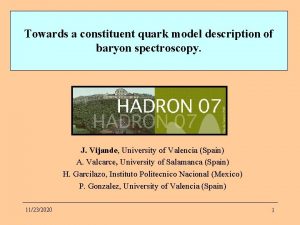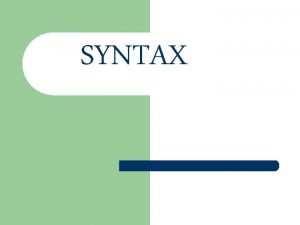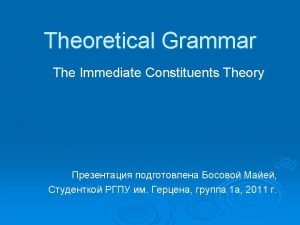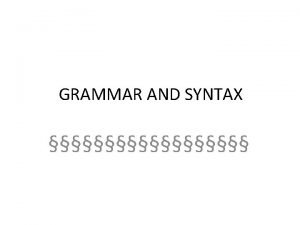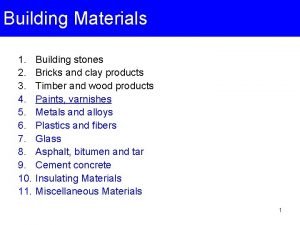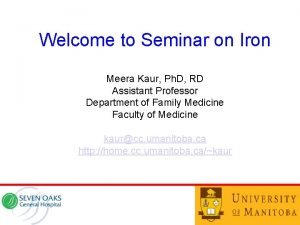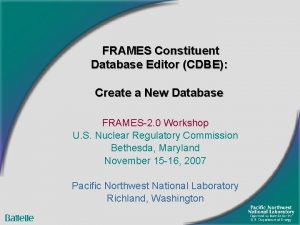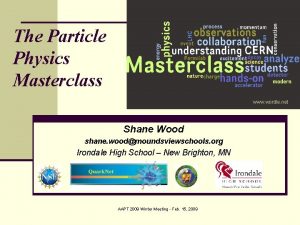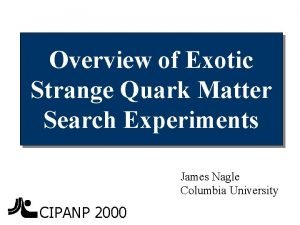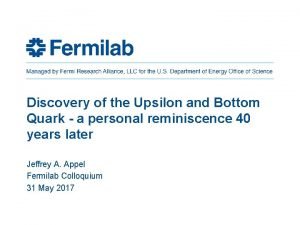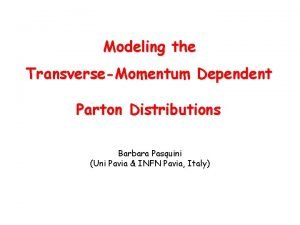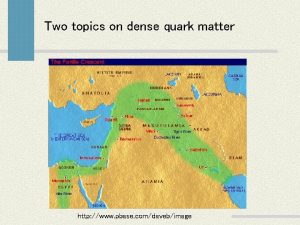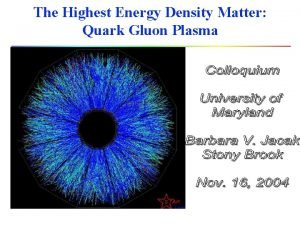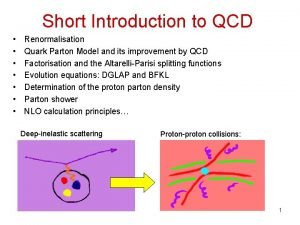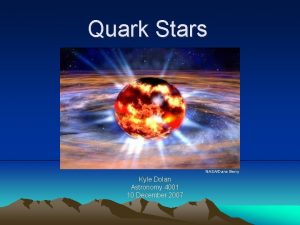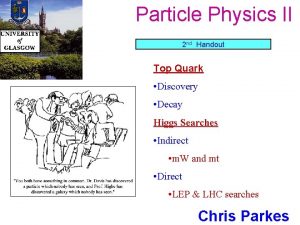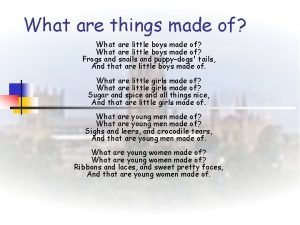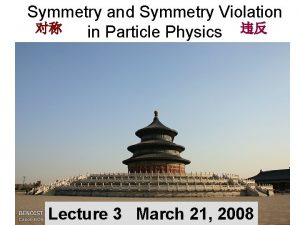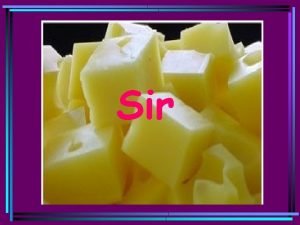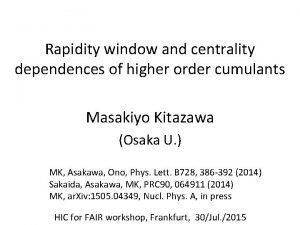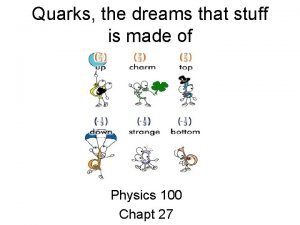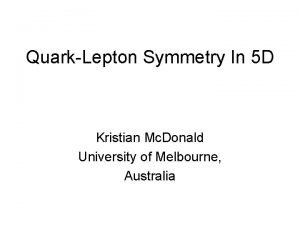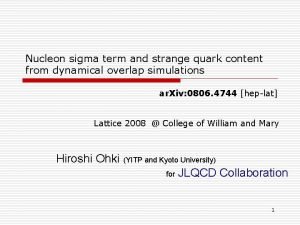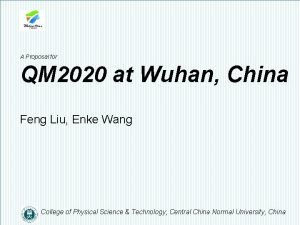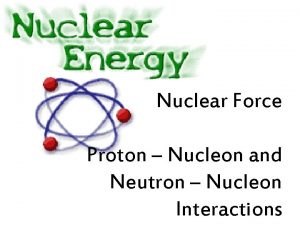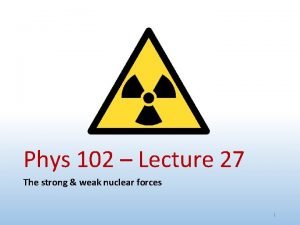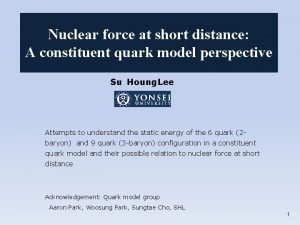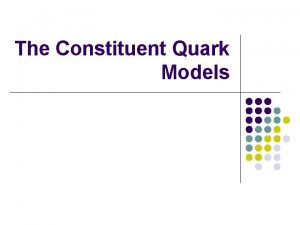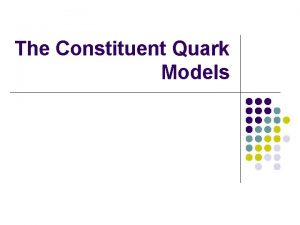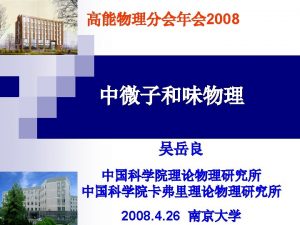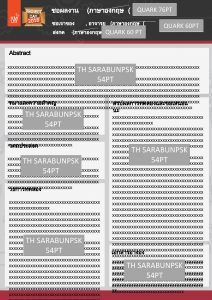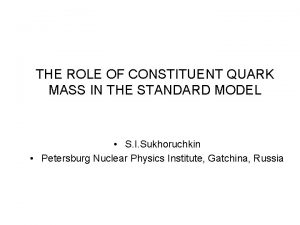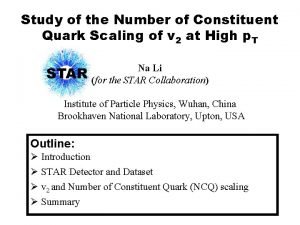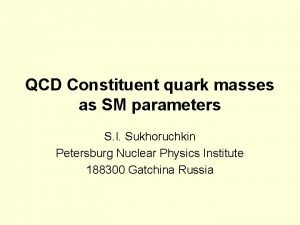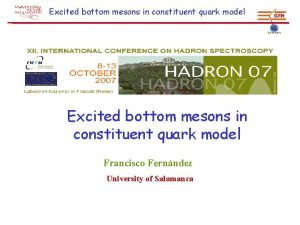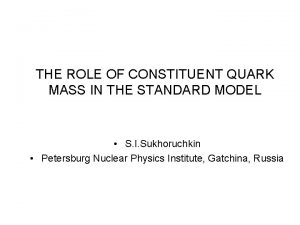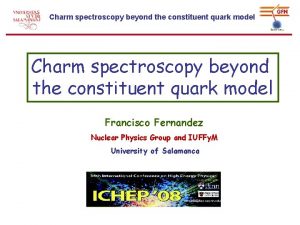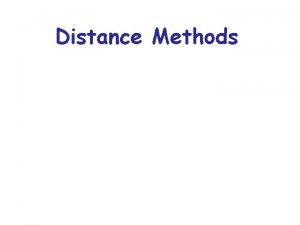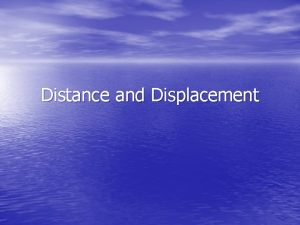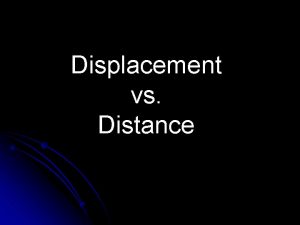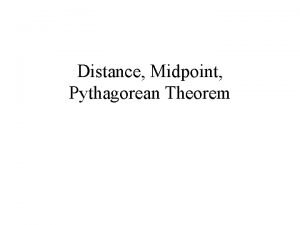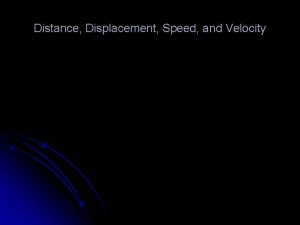Nuclear force at short distance A constituent quark





![d*(2380) - WASA-at-COSY [H. Clement]- Revival of an old topic Scalar tetraquark (Jaffe 76) d*(2380) - WASA-at-COSY [H. Clement]- Revival of an old topic Scalar tetraquark (Jaffe 76)](https://slidetodoc.com/presentation_image_h/1493229d47a752f6989ae3218fa384ed/image-6.jpg)



























- Slides: 33

Nuclear force at short distance: A constituent quark model perspective Su Houng Lee Attempts to understand the static energy of the 6 quark (2 baryon) and 9 quark (3 -baryon) configuration in a constituent quark model and their possible relation to nuclear force at short distance Acknowledgement: Quark model group Aaron Park, Woosung Park, Sungtae Cho, SHL 1

I. Few words on “Multiquark states” II. Constituent quark model, Multiquark states and Short distance 2 -N static energy III. Tribaryons and short distance 3 -N static energy 2

Few words on “Multiquark states” 3

X(3872) - 2003 - Z(4430) - 2007 - - 2014 Spin parity = 1+ G=+ will look at C=- 4

Pentaquark - Pc - 2015 - Baryon with ccu PRL 119 (2017)112001 - 2017 - 5
![d2380 WASAatCOSY H Clement Revival of an old topic Scalar tetraquark Jaffe 76 d*(2380) - WASA-at-COSY [H. Clement]- Revival of an old topic Scalar tetraquark (Jaffe 76)](https://slidetodoc.com/presentation_image_h/1493229d47a752f6989ae3218fa384ed/image-6.jpg)
d*(2380) - WASA-at-COSY [H. Clement]- Revival of an old topic Scalar tetraquark (Jaffe 76) Search for H dibaryon 6

Normal meson, compact multiquark, molecules, resonances Normal meson Compact multiquark Molecules u Geometrical configuration Examples u d Nucleon, pion, kaon u u d u ? Pc, d* d Resonance u u u d d d X(3872) K*, rho meson 7

II: Constituent quark model, Multiquark states and Short distance 2 -N static energy 8

• NN potential in SU(3) from Lattice: HAL QCD (PTEP 2012, 01 A 105) Spin=0 Spin=1 Highly repulsive Spin=0 Spin=1 Attractive Spin=0 Spin=1 Weakly repulsive 9

Compact dibaryon states and nuclear force at short distance - Long distance nuclear force: meson exchange 1 2 q 5 4 q 3 6 - Short distance dynamics could be understood using quark dynamics M. Oka; quark cluster model 1 2 3 5 4 6 10

Quark wave function for multiquark states (W. Park, A. Park, S. Cho, SHL) • Pauli principle: Totally antisymmetric (color x spin x flavor) wave function (s-wave quarks) 1 4 2 3 5 6 Can be use to understand 1) Compact dibaryon states 2) NN potential at short distance 11

Quark wave function for light dibaryons (W. Park, A. Park, SHL 15. ) - Choose the spatial part to be symmetric - Choose the Color-Flavor-Spin part to be antisymmetric : SU(12) Physical State 12

- Dibaryon: 5 Independent color singlet bases 12 34 56 13 24 56 12 35 46 13 25 46 14 25 36 13

Storng repulsion at short distance Pauli forbidden 6 quark state Example 1: WW in the Spin=3 channel is highly repulsive because Flavor is totally symmetric Spin is totally symmetric Remaining part should be totally antisymmetric But color singlet implies Hence, short distance repulsion in this channel Example 2: NN in spin 0, octet channel Such forbidden configuration are highly repulsive at r 0 (Oka et al quark cluster model) what about states that are allowed? 14

Constituent quark model • In Constituent quark model (Can fit experimental hadron spectrum well) d u q s . . In this talk, Will concentrate on the Color-Spin-Flavor part 15

• Baryon Mass splitting in a simplified version Example d u s u d s Mass diff MD –MN MS-ML MSc-MLc MSb-MLb Formula 290 Me. V 77 Me. V 154 Me. V 180 Me. V Experiment 290 Me. V 75 Me. V 170 Me. V 192 Me. V 16

When allowed, Where are the Compact multiquark configuration? • Kinetic energy part Compact state 6 quark state vs 2 separated baryons Additional kinetic energy 1 2 3 5 4 6 17

• Color-Color interaction Related to Casimir If color singlet 1 Sum of color-color interaction is additive 2 3 5 4 6 when the total number of quarks NTotal=NB 1+NB 2 18

• Quark 3 -body force Two types - Note, related to 2 Casimir 3 -quark interaction are additive: For color singlet state composed of NTotal=NB 1+NB 2 quarks 19

• Color spin interaction Color-spin interaction for quark-quark and quark antiquark quark-quark and quark-antiquark qq qq Color A S Flavor A A S S A(1) S(3) -8 -4/3 8/3 Spin K u d 1 8 A(1) 1 1 3 3 4 -16 2 16/3 -2/3 u d 20

• Color spin interaction - General remarks 1) Part of a larger group 21

• Color spin interaction - General remarks II 2) Color –flavor-spin wave function should be totally antisymmetric. (Aerts, Mulders, de Swart 78) 22

Short distance energy is dominated by color-spin interaction 1 2 5 4 3 6 23

• Comparison with lattice – NN interaction in SU(2) K of 6 quark state and their decays (W Park, A Park, Lee 2015) For P, N and L Positive for all 6 quark configuration comparison 24

• Divide by V(1) part at short distance at look at ratios Spin=0 Spin=1 Highly repulsive Spin=0 Spin=1 Attractive Spin=0 Spin=1 Weakly repulsive 25

• Comparison with lattice – HAL QCD SU(3) vs quark model-- preliminary A. Park y-axis: ratio x-axis: fm 26

III. Tribaryons and Short distance repulsive three body nuclear force 27

• Three body nuclear force is repulsive at short distance 1) Review by Sakuragi (PTEP 2016, 06 A 106) 2) Hyperon Puzzle : slide by Tamura 28

• Tribaryon configurations (Aaron Park, W. Park, SH Lee PRD 98(2018)034001) 1) Color singlet x Flavor spin state 2) Possible Flavor state 29

• Color spin interaction - General remarks Tribaryon configuration (Aaron Park) 1) SU(2): Three nucleons For nucleon K= -8, But Tribaryon (N=9) K>>0 2) SU(3): Including hyperons All tribaryon channel is very repulsive Three Baryon force should be repulsive with or without strangeness 30

• Color spin interaction - Tribaryon configuration with broken SU(3) 1) With one strangeness and isospin 0 With one strangeness: least repulsive state is S=3/2, Flavor antidecuplet 31

• Purely three body repulsion 2 -Nucleon 3 -Nucleon 1) SU(2): Triton configuration (I, S)=(1/2, 1/2) 2) Configuration with one strange quark Intrinsic three nucleon forces are repulsive 32

Summary - Constituent quark model can be used to study multiquark configurations: d*, Pc, X(3872), Z are most likely molecular states - Qualitative features of the short distance Nuclear two-body repulsion from HAL QCD can be understood from a very simple constituent quark picture - Short distance Nuclear three-body interactions seems to be repulsive in the NNN and NNL configurations even in the SU(3) symmetry breaking case as required from phenomenology more work in progress and looking forward to more lattice data on this 33
 Long and short
Long and short Constituent quark model
Constituent quark model Lesson 15 nuclear quest nuclear reactions
Lesson 15 nuclear quest nuclear reactions Fisión nuclear vs fision nuclear
Fisión nuclear vs fision nuclear Syntax
Syntax Back-formation linguistics
Back-formation linguistics Immediate constituent analysis
Immediate constituent analysis Constituent analysis
Constituent analysis Crm constituent relationship management
Crm constituent relationship management Paint classification
Paint classification Elements of intercultural competence
Elements of intercultural competence Factors affecting iron absorption
Factors affecting iron absorption Cdbe
Cdbe Physics wordle quark
Physics wordle quark Color quarks
Color quarks Quark names
Quark names Barbara pasquini
Barbara pasquini Quark gluon
Quark gluon Quark gluon
Quark gluon Quark parton model
Quark parton model Quark astronomy
Quark astronomy Quark gluon
Quark gluon Top quark decay
Top quark decay Quark names
Quark names A charm quark has a charge of approximately
A charm quark has a charge of approximately Caprodur sir
Caprodur sir Quark gluon plasma
Quark gluon plasma 6 types of quarks
6 types of quarks Quark lepton symmetry
Quark lepton symmetry Sigma quark composition
Sigma quark composition Quark matter 2022
Quark matter 2022 Nuclear force field
Nuclear force field Strong vs weak nuclear force
Strong vs weak nuclear force Nuclear force
Nuclear force

